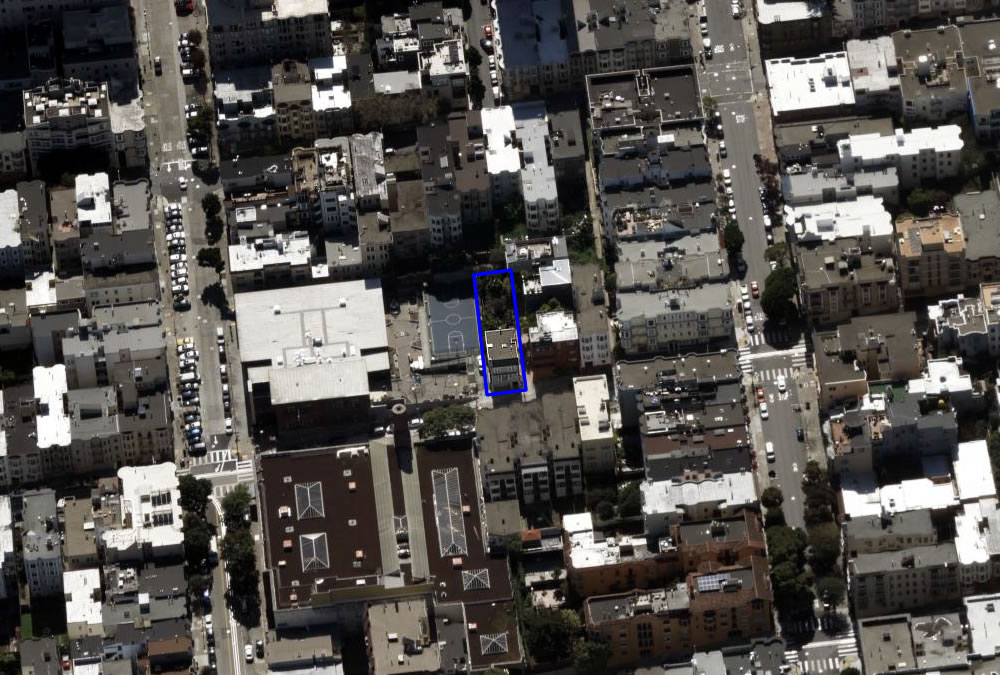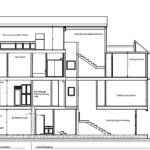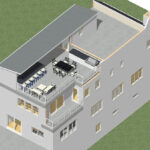Plans to expand the 2,300-square-foot, detached Nob Hill home which sits on the front of a 3,571-square-foot lot at 1151 Washington Street, adjacent to the Betty Ong Recreation Center’s playground, were drafted back in 2012 when the home sold (for $1.85 million) but have yet to be realized.
A formal application to add roughly 2,200 square feet of living space to the home, by way of a rear addition and a new roof deck with a covered outdoor kitchen, was finally submitted to the city in 2019, at which point building permits for the project were requested as well.
The plans were subsequently challenged by neighbors, however, who argued that the proposed project was “out of scale for the neighborhood,” could impact the adjacent Recreational Center’s playground (by way of shadows which hadn’t been quantified), and was “far too big for this small lot” (which the uphill neighbor’s attorney hypothesized could create “a health and safety issue” as the expansion could obstruct the owner of 1151 Washington from “bring[ing] his garbage cans around the side of his house” to the curb, as is his current approach).
The proposed expansion would also “unnecessarily block the [uphill neighbor’s] views.” And yes, the uphill neighbor’s proposed remedy to resolve the aforementioned “scale, shadow, health, and safety issues” related to the expansion was to eliminate the view-blocking rooftop addition from the plans (and then build farther back on the “small lot”).
In the meantime, interim controls “to maximize residential density, and avoid the creation of larger dwelling units that are inherently less affordable” was drafted, passed and became effective this past January, legislation that requires Conditional Use Authorization for any residential project within a RC, RM or RTO zoned district in San Francisco that would either create or expand a dwelling unit in the city that’s larger than 2,000 square feet though the middle of next year. And the parcel upon which the 2,300-square-foot home at 1151 Washington sits is zoned RM-3.
From Planning with respect to the since requested Conditional Use Authorization for the proposed expansion of 1151 Washington Street:
The Project is located within an area primarily characterized by multi-family residential development that is well suited for higher residential density [with a lot that could support the development of up to 9 units without taking other code restrictions into account]. The size of the existing single-family dwelling is already substantially larger than the 2,000 square foot threshold set by the interim controls, and the Project would significantly expand the unit to over 5,000 square feet. Such larger units are inherently less affordable, and complicate the ability of the property to accommodate additional dwelling units in the future. The Project does not assist in addressing the formidable housing affordability issues that are the subject of the interim controls, as well as many other recent legislative efforts and the State and local level.
And with that in mind, San Francisco’s Planning Department is recommending that San Francisco’s Planning Commission reject the requested Conditional Use Authorization for the proposed expansion of 1151 Washington Street, the hearing for which is slated to be held this week. We’ll keep you posted and plugged-in.



Should the city be able to decide what is ‘too big’ for a home? Is this a private owner?
Cities have had zoning power for about a century now… It was controversial at first, but it’s been settled for a while.
It seems like sometimes people believe it’s fine for cities to restrict lower-income homes (ie smaller apartments, no parking, limited outdoor space) but anathema to restrict luxury housing. Which is funny.
Mistresspants: you seem to have missed the text in the post above which clearly identifies the applicable zoning as multi-family. If this property was in an area zoned for single family homes only, then perhaps your umbrage would be well-placed.
Also, I am confused. Is this legislation different than the ‘monster home’ proposal that was just introduced earlier in the year and has not been passed? Pardon my ignorance.
That’s correct, as (further) outlined above. It’s an/the interim control that’s currently in place.
Well, that Discretionary Review (DR) request backfired! Hopefully there will be less abuse of the DR process, now that planning is trying to support more density.
Regarding the Mandelman size restriction legislation, the planning commission unanimously voted it down, so presumably the interim control has been abolished.
The interim control, as outlined above, remains in place through the middle of next year.
I’m in favor of monster homes in SF. Hear me out.
– Monster homes bring monster tax revenues as they will be reassessed after construction.
– Monster homes are homes for the executives that start and run companies in SF proper. We need those companies within city limits.
– It strikes me as unlikely that medium sized SFH’s like will be converted to upwards of nine units, as planning says. It’s a pipe dream. An in-law unit, maybe.
Build dense housing in all of the normal places (parking lots, auto body shops etc) but Let Them Build Monsters, too.
1. So will apartment houses.
2. Companies need employees more than they need executives. A company with executives and money, but which can’t find employees, isn’t going to last long. A company which can find employees and is generally viable will find some executives, one way or another, regardless of whether there are enough fancy homes nearby (and there are plenty of fancy homes nearby).
Not to mention– all the other businesses and services that make the city function do a lot better with a bunch of reasonably-well-paid residents than with a few uber-wealthy (part time) residents.
3. It’s 5000 square feet. That’s easily five apartments, and more if they’re small.
1) I think it’s more likely that a 2,000 square foot SFH gets converted to a 5,000 square foot home than get converted to a five unit apartment. It’s an idealistic vs realistic thing. I don’t think converting SFH’s into five unit buildings is realistically going to happen at scale (and the city gets no new revenue), whereas allowing SFH’s to upsize gets the city more revenue.
2) You’re right, companies need employees more than executives. This is the top priority. I recommend we build a tremendous amount of new “workforce housing” as well, mostly involving demolishing 1-3 story commercial buildings, gas stations, autobody shops or parking lots in favor of multi-family buildings.
1) What revenue is that? Property tax? A new apartment building pays that as much as a new large house. Whether a new 5000 sf 5-unit condo/apartment building pays more or less than a new 5000 sf SFH, I don’t know, but I don’t expect they’re radically different.
I don’t know what you mean by “at scale”… granted I don’t expect 50% of all houses to be rebuilt in the next ten years, but then I don’t expect them to be expanded into giant SFHs either. Looking around my neighborhood, a small old SFH has been as likely to become an apartment house as a large SFH, if not more so. Especially now that the city has removed some obstacles (e.g. parking requirements), which used to favor the large SFH route.
2. Sure. Porque no los dos?
The project was started years ago. Have zoning or planning rules changed since then? Single family home owners should be able to satisfy their own needs for expansion of their single family homes. How many other projects started during this time were entitled?
UDPATE: New Plans for a Wall of Ten Townhomes to Rise Right Here